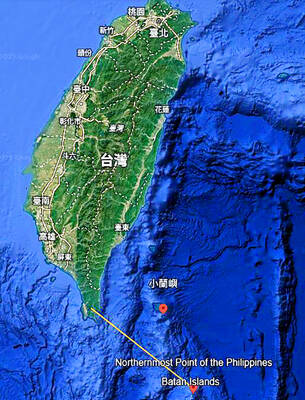The Fisheries Agency yesterday released information concerning Kuang Ta Hsing No. 28’s position and movement throughout its voyage to disprove the claim by the Philippines that the fishing boat had intruded into its territorial waters, leading to the fatal shooting of Taiwanese fisherman Hung Shih-cheng (洪石成).
From the time the 15-tonne Kuang Ta Hsing No. 28 left Siaoliouciou (小琉球), an island off Pingtung County, on May 4, until it was disabled by Philippine Coast Guard personnel on May 9, the voyage data recorder (VDR) system onboard “was kept operational all along the voyage,” Fisheries Agency Deputy Director-General Tsay Tzu-yaw (蔡日耀) said.
Tsay said the information from the boat’s VDR, which recorded vital information related to the vessel’s operation, showed that the boat was operating within the nation’s exclusive economic zone and had never entered the territorial waters of the Philippines.

Photo: Huang Liang-chieh, Taipei Times
According to the information, the ship arrived at 20o north latitude and 123o east longitude at 2:30am on May 7 and was operating in the area between 19o 50 minutes and 20o 10 minutes north latitude, and between 122o 48 minutes and 123o 25 minutes east longitude until 8:24am on May 9, Tsay said.
From midnight on May 9 to 6:18am that day, the ship was sailing west by south at a speed of between 3 knots and 8 knots (5.6kph and 14.8kph) before it arrived at 19o 57 minutes north latitude, 122o 48 minutes east longitude, where it sailed at a lower speed of between 0 knots and 1 knot, he said.
The data showed that the ship sailed at a speed of between 4 knots and 5 knots in an east-south-east direction at 8:24am that day, while its speed increased to 10 knots at 10:12am, when its location was measured at 19o 59 minutes north latitude, 122o 55 minutes east longitude, “presumably being chased” by the Philippine vessel, Tsay said.
Tsay said the ship lost power at 11:24am at 20o 7 minutes, 123o east longitude, when its speed was measured at zero, data showed.
Analysis of the information has showed that it “contained no disruption to data recording during the voyage,” meaning that that the VDR system was operational, Tsay said.
The claims by the Philippines that its coast guard personnel were carrying out their duty to stop illegal fishing were “defamatory,” Tsay said.
“We have shown our evidence, but they haven’t,” he said.
Meanwhile, the Ministry of Justice said the Philippines had agreed to allow Taiwanese investigators to board the Philippine vessel that attacked the Kuang Ta Hsing No. 28.
Deputy Minister of Justice Chen Ming-tang (陳明堂) said the Philippines had agreed to allow Taiwanese investigators to inspect the firearms used and compare ballistics results with those obtained by Philippine investigators.
Chen said ministry official Yang Wan-li (楊婉莉) is now negotiating matters involving the investigation with the authorities in Manila.
The ministry is seeking to see the video of the incident shot by the Philippine patrol boat, but the negotiation is ongoing, Chen said.
He said the Philippines refused to allow Taiwanese to interview Philippine Coast Guard officers, but the ministry hoped that questions prepared for the suspects could be asked by Philippine investigators.
He reiterated that allowing Taiwanese investigators to join the probe in Manila would not intrude on the Philippine’s judicial sovereignty.
Chen said the ministry has agreed to Manila sending a team to Taiwan.
Earlier on Monday, Philippine Secretary of Justice Leila de Lima reiterated her opposition to the idea of a joint investigation, saying that Taiwan and the Philippines were instead conducting “parallel” or “respective” investigations.
“It’s not advisable to agree to a joint probe, because you know, aside from sovereignty issues involved, there is foreign policy implications involved because of the ‘one China’ policy,” De Lima said.
However, a Taiwanese team would be allowed to view written testimony given by the officers, De Lima said.
The Philippines has also expressed interest in sending its investigators to Taiwan to gain further information on the shooting.
De Lima said Manila hoped to meet the Taiwanese fishermen who were on the boat at the time of the incident and get their statements, as well as conduct another autopsy on the deceased fisherman, if his family agrees.
De Lima said that the Philippine National Bureau of Investigation had completed its investigation in the Philippines and was waiting to go to Taiwan to continue the investigation there, before issuing a final report.

SECURITY: As China is ‘reshaping’ Hong Kong’s population, Taiwan must raise the eligibility threshold for applications from Hong Kongers, Chiu Chui-cheng said When Hong Kong and Macau citizens apply for residency in Taiwan, it would be under a new category that includes a “national security observation period,” Mainland Affairs Council (MAC) Minister Chiu Chui-cheng (邱垂正) said yesterday. President William Lai (賴清德) on March 13 announced 17 strategies to counter China’s aggression toward Taiwan, including incorporating national security considerations into the review process for residency applications from Hong Kong and Macau citizens. The situation in Hong Kong is constantly changing, Chiu said to media yesterday on the sidelines of the Taipei Technology Run hosted by the Taipei Neihu Technology Park Development Association. With

CARROT AND STICK: While unrelenting in its military threats, China attracted nearly 40,000 Taiwanese to over 400 business events last year Nearly 40,000 Taiwanese last year joined industry events in China, such as conferences and trade fairs, supported by the Chinese government, a study showed yesterday, as Beijing ramps up a charm offensive toward Taipei alongside military pressure. China has long taken a carrot-and-stick approach to Taiwan, threatening it with the prospect of military action while reaching out to those it believes are amenable to Beijing’s point of view. Taiwanese security officials are wary of what they see as Beijing’s influence campaigns to sway public opinion after Taipei and Beijing gradually resumed travel links halted by the COVID-19 pandemic, but the scale of

A US Marine Corps regiment equipped with Naval Strike Missiles (NSM) is set to participate in the upcoming Balikatan 25 exercise in the Luzon Strait, marking the system’s first-ever deployment in the Philippines. US and Philippine officials have separately confirmed that the Navy Marine Expeditionary Ship Interdiction System (NMESIS) — the mobile launch platform for the Naval Strike Missile — would take part in the joint exercise. The missiles are being deployed to “a strategic first island chain chokepoint” in the waters between Taiwan proper and the Philippines, US-based Naval News reported. “The Luzon Strait and Bashi Channel represent a critical access

Pope Francis is be laid to rest on Saturday after lying in state for three days in St Peter’s Basilica, where the faithful are expected to flock to pay their respects to history’s first Latin American pontiff. The cardinals met yesterday in the Vatican’s synod hall to chart the next steps before a conclave begins to choose Francis’ successor, as condolences poured in from around the world. According to current norms, the conclave must begin between May 5 and 10. The cardinals set the funeral for Saturday at 10am in St Peter’s Square, to be celebrated by the dean of the College